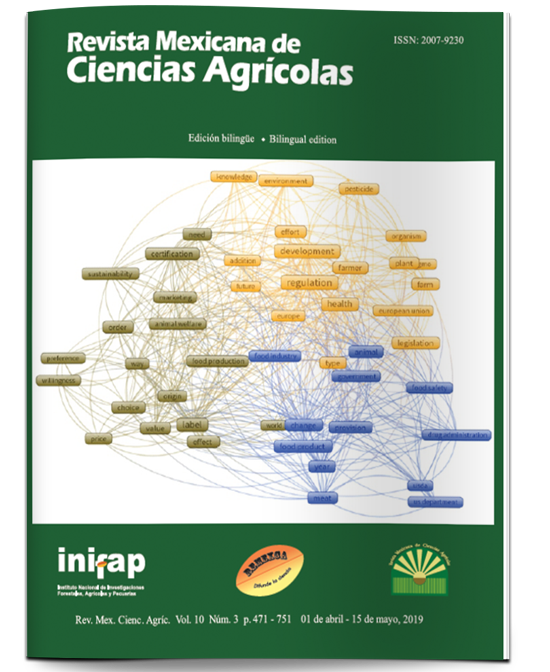Variability in soluble carbohydrates of the stem and its contribution to grain yield in wheat
DOI:
https://doi.org/10.29312/remexca.v10i3.1540Keywords:
Triticum aestivum L., defoliation, soluble carbohydrates, water stressAbstract
In wheat, the capacity to store soluble carbohydrates (CHS) in the stem and to remobilize them towards the grain, constitutes a desirable characteristic to be incorporated in the germplasm directed to regions where terminal drought frequently occurs. The objective of the work was to evaluate the variability in the accumulation and remobilization of water-soluble carbohydrates (CHS) and their contribution to grain yield when the post-synthesis source is altered by defoliation and water stress. The experiments were carried out in the summer-autumn 2013 cycle (temporal, exp. 1) and winter-spring 2013-2014 (irrigation, exp. 2) in Toluca, Mexico, at a density of 350 seeds m-2, in the exp 1 the defoliation was performed 7 days after anthesis and in the exp. 2 was not watered after anthesis. In the exp. 1 60 wheat elite lines and two source reduction treatments (defoliated and defoliated, called environments onwards) were studied under a split plot design with 2 replications. The exp. 2 consisted of 20 genotypes selected from exp. 1 and subjected to two water regimes (irrigation and post-flowering drought) in a randomized complete block design with 3 replications where each water regime was considered an environment. Great variability was observed for grain yield (RG) and the associated physiological characteristics. The RG was reduced by an average of 14% due to defoliation and post-anthesis drought. The greater contribution of CHS was in line with a greater efficiency of remobilization. There are promising genotypes for use in breeding programs with a view to incorporating physiological characteristics to increase the potential yield under conditions of biotic or abiotic stress in post-anthesis.
Downloads
Downloads
Published
How to Cite
Issue
Section
License
The authors who publish in Revista Mexicana de Ciencias Agrícolas accept the following conditions:
In accordance with copyright laws, Revista Mexicana de Ciencias Agrícolas recognizes and respects the authors’ moral right and ownership of property rights which will be transferred to the journal for dissemination in open access. Invariably, all the authors have to sign a letter of transfer of property rights and of originality of the article to Instituto Nacional de Investigaciones Forestales, Agrícolas y Pecuarias (INIFAP) [National Institute of Forestry, Agricultural and Livestock Research]. The author(s) must pay a fee for the reception of articles before proceeding to editorial review.
All the texts published by Revista Mexicana de Ciencias Agrícolas —with no exception— are distributed under a Creative Commons License Attribution-NonCommercial 4.0 International (CC BY-NC 4.0), which allows third parties to use the publication as long as the work’s authorship and its first publication in this journal are mentioned.
The author(s) can enter into independent and additional contractual agreements for the nonexclusive distribution of the version of the article published in Revista Mexicana de Ciencias Agrícolas (for example include it into an institutional repository or publish it in a book) as long as it is clearly and explicitly indicated that the work was published for the first time in Revista Mexicana de Ciencias Agrícolas.
For all the above, the authors shall send the Letter-transfer of Property Rights for the first publication duly filled in and signed by the author(s). This form must be sent as a PDF file to: revista_atm@yahoo.com.mx; cienciasagricola@inifap.gob.mx; remexca2017@gmail.
This work is licensed under a Creative Commons Attribution-Noncommercial 4.0 International license.



